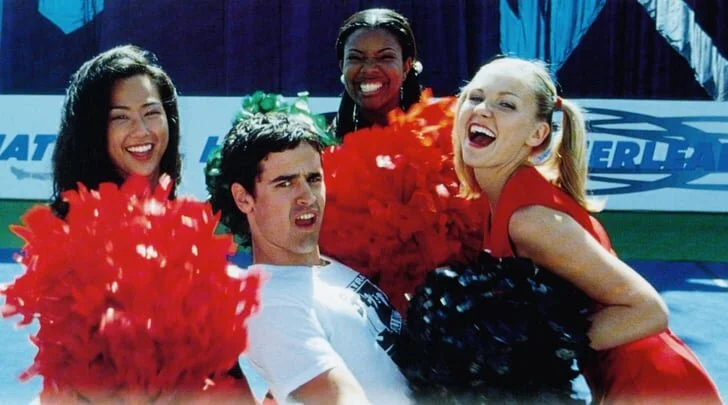You Can't Sit With Us: Sexy, Cute, and Popular to Boot
by Emily Maesar, Staff Writer
Nothing screams American high school quite like football and cheerleading. There’s just something about the sports, both separately and together, that harkens back to the creation of the American Teen. Even if the sports have modernized, the perception of them in media and in high schools around the country hasn’t changed all that much. All of which leads me into talking about teenage sports movies, through two of the most iconic: Friday Night Lights and Bring It On.
Released within four years of each other, these two films represent the spectrum of teenage sports films that exist in a modern era, and that any more recent films in the genre are based on. They also represent a turn in American exceptionalism through high school sports because the protagonists don’t win. It’s a worthy lesson within the context, but also outside of it. You can truly give it your all, and still lose big.
So, in the year 2000, Bring It On was thrust upon an American teen audience in the year after the “Greatest Film Year Ever.” And in the teen film category, even in the broadest of terms, there were very slim pickings - especially if you wanted a good film. Like, Cameron Crowe’s classic Almost Famous was maybe the only other truly great teen film from that year. It was a dark time before the absolute renaissance of teen comedies that flooded the film market only a few years later.
The film in question, written by Jessica Bendinger and directed by Payton Reed, was released in late summer. It follows the Rancho Carne Toros in San Diego, a (mostly) white cheer squad. When their previous captain graduates from high school, Torrance Shipman (Kristen Dunst) is elected as their new leader. After a girl is injured on her first day, they have to hold tryouts for a replacement. Enter Missy Pantone (Eliza Dushku), who makes the team… only to realize that their former captain had been stealing all their cheer routines, both the ones for the football games and the ones for competition, from the (mostly) Black East Compton Clover squad up in Los Angeles. Armed with this knowledge the Toros eventually decide to create whole new routines for their major competition, eventually losing to the Clovers at Nationals.
Now, I was eight when Bring It On came out, but that film very quickly became not only one of my classics, but a general classic in the teen film world. While the critical media was sort of mixed on the film, Roger Ebert gave it a 2 out of 4, the world at large circled back on it. Like, it became a staple in not just sports movies for girls, but teen media at large. Ebert even eventually called it “the Citizen Kane of cheerleading movies.” And maybe part of that was the film compared to other cheerleading movies (Ebert made the comment in a piece about the 2009 film Fired Up!, which is… not a great film), but I think it’s a pretty solid film about having all your preconceived notions crash down around you as a teenager.
Because, outside of all the skirts, flips, and spirit sticks, that’s what Bring It On is actually about. There’s very little parental involvement in this film, so the idea of needing to compete and win for adults isn’t really present (not in the same way it is in Friday Night Lights, which we’ll talk about later). So, instead the film is all about competing and winning for the sake of the squad, and for personal achievement. Which is why it’s so soul crushing when Missy brings Torrance’s world down around her by showing her that Big Red was stealing all their routines. And she goes through some denial about her cheerleading career being built on lies… until she comes to her senses and realizes that they have to make the best of the situation. They have to actually try, to work their asses off, if they actually hope to win. No more resting on their laurels.
Which, besides how fun it is to watch athletes do very cool stuff, is a pretty solid reason to love Bring It On. As explored in the film, it becomes a lesson in the possibility of meritocracy. That maybe just because you’re white doesn’t mean you always win. And just because you try your best, doesn’t mean you’re actually the best. But Bring It On doesn’t look at the Toros losing to the Clovers as a defeat, because the film does a lot to make you root for the Clovers too. And when you see both routines at the end of the film, they both fucking rule. However, your best isn’t always the best, and that’s an important lesson for teenagers (especially type-A teenagers) to learn.
On the opposite end of the spectrum, however, is Friday Night Lights. Based on the 1990 non-fiction book by H.G. Bissinger Friday Night Lights: A Town, a Team, and a Dream, Peter Berg’s 2004 film follows the 1988 Permian High School football season in Odessa, Texas. The film takes a look at a few key players on the team, as well as their coach, as they fight to get to and win the state championship for the year.
Now, I recognize that I’ve been looking at a lot of teen films over the last few months that are pretty focused on the experiences of teenage girls. This is in large part due to the fact that those are the films that spoke to me as I was growing up, but it’s also because the film industry (like culture at large) doesn’t do very well to give teenage boys complex and multifaceted stories. Which seems like a weird thing to say, given the patriarchy of it all, but part of that patriarchal control is that men’s emotions are highly controlled and regulated.
Which is where sports movies, among a small plethora of other types of media, come in. Sports often allow a lot of bottle up emotions to come pouring out - for better or for worse. And full contact sports like football end up being a kind of catharsis through violence - and there’s nowhere better to put all the horror of being a teenage boy than into football. But another thing that’s really prevalent in teen sports films at large, is the encroaching parental forces.
In Friday Night Lights, for example, all the boys who are front and center in the narrative have a conflicting and messy home life. They’re fighting to make their lives better, regardless of if that’s for their parents or in spite of them. And centering the film, in part, on the coach of the team is also an important aspect of teenage sports films. For all the messiness of being a teenage boy with the entire town’s hopes and dreams riding on your back (big yikes from me!), the audience needs to know that there’s an actual adult in there somewhere who’s got everything under control.
However, in all honesty, American teen sports films are kind of few and far between. There are a few that set the mold, but not many films that have come after have actually aimed to break it and forge a new path. And certainly the films that are set in the genre are much more hybrid than their predecessors, as the sporty aspects of teen films often get integrated into other sub-genres within the demographic. Which is kind of a shame, considering that sports films are one of the few genres of teen film that’s often made with the express ideal of being for teenage boys to have a kind of approved and regulated emotional reaction.
I think that the advent of our very online presence in the last ten years has played a big part in the types of media, especially teen media, that people are willing to create. Because what do sports even look like in high schools these days? I’d imagine a lot of stress teenages felt over various sports in high school before… has been replaced with the stress of trying to make it on social media. But at least when you failed at winning the championship game, you lost as a team. I’d be interested to see if teen sports movies ever really make a comeback, but I have a feeling that we’ve seen the best of them (for at least a while).




